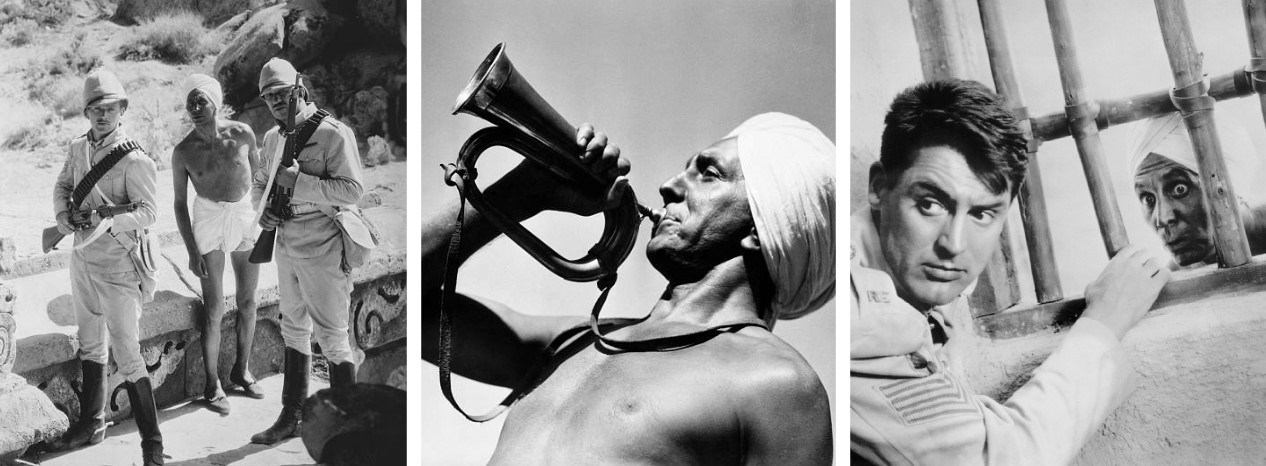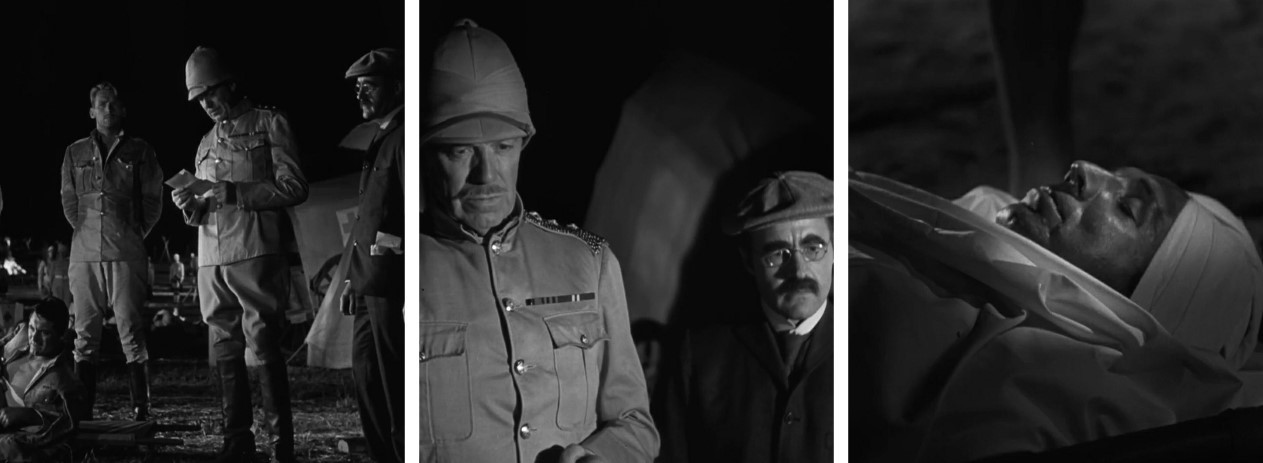Film Friday: Gunga Din (1939)
Because of the Kirk Douglas blogathon, I was not able to write my «Film Friday» article on time. So, this week's «Film Friday» comes on a Sunday instead. I am honoring Douglas Fairbanks Jr.'s 107th birthday, which was also on Friday, by telling you about one of the first films I ever saw with him.
Directed by George Stevens, Gunga Din (1939) begins in an encampment of Her Majesty's Lancers in Colonial India, where the commanding officer, Colonel Weed (Montagu Love), learns that the telegraph wires to one of their outposts have been cut. To investigate the matter, he dispatches a detachment of 25 troops, led by his three most dependable sergeants: the calculating Archibald Cutter (Cary Grant), ever dreaming of discovering a hidden treasure; the grizzled veteran «Mac» MacChesney (Victor McLaglen); and the gentlemanly Thomas «Tommy» Ballantine (Douglas Fairbanks Jr.), whose sole focus is his imminent discharge and marriage to his fiancé, Emaline «Emmy» Stebbins (Joan Fontaine). Among the troops taken on the mission is the humble bhishti Gunga Din (Sam Jaffe), who longs to become a soldier of the Queen.
Directed by George Stevens, Gunga Din (1939) begins in an encampment of Her Majesty's Lancers in Colonial India, where the commanding officer, Colonel Weed (Montagu Love), learns that the telegraph wires to one of their outposts have been cut. To investigate the matter, he dispatches a detachment of 25 troops, led by his three most dependable sergeants: the calculating Archibald Cutter (Cary Grant), ever dreaming of discovering a hidden treasure; the grizzled veteran «Mac» MacChesney (Victor McLaglen); and the gentlemanly Thomas «Tommy» Ballantine (Douglas Fairbanks Jr.), whose sole focus is his imminent discharge and marriage to his fiancé, Emaline «Emmy» Stebbins (Joan Fontaine). Among the troops taken on the mission is the humble bhishti Gunga Din (Sam Jaffe), who longs to become a soldier of the Queen.
Arriving at the outpost, the three sergeants find the compound in the hands of a band of killers known as the Thuggees, who are members of a fanatic religious order that has sworn to annihilate the British in India. The sergeants managed to fend off their attack, and upon their triumphant return to their post, Cutter and MacChesney begin to scheme to keep Ballantine in service.
Meanwhile, Gunga Din leads Cutter to a temple of gold, which turns out to be the holy shrine of the Thuggees. As he decoys the Thuggees, Cutter sends Gunga Din back to the post for reinforcements. MacChesney uses Cutter's perilous situation to trick Ballantine into reenlisting in the rescue mission and the two ride out to save their friend. However, they have misunderstood Gunga Din and, believing that Cutter is being held by priests, they enter the temple by themselves and are easily captured by the Thuggees. As the British force marches towards the temple, Gunga Din realizes his dreams by sounding the bugle to warn them of the ambush, sacrificing his life for his sense of duty. Saved by Gunga Din's warning, the British defeat the Thuggees and rescue the sergeants. Later, Ballantine decides to remain in service, and Gunga Din is appointed a corporal in the British Army and is buried with military honours.
Meanwhile, Gunga Din leads Cutter to a temple of gold, which turns out to be the holy shrine of the Thuggees. As he decoys the Thuggees, Cutter sends Gunga Din back to the post for reinforcements. MacChesney uses Cutter's perilous situation to trick Ballantine into reenlisting in the rescue mission and the two ride out to save their friend. However, they have misunderstood Gunga Din and, believing that Cutter is being held by priests, they enter the temple by themselves and are easily captured by the Thuggees. As the British force marches towards the temple, Gunga Din realizes his dreams by sounding the bugle to warn them of the ambush, sacrificing his life for his sense of duty. Saved by Gunga Din's warning, the British defeat the Thuggees and rescue the sergeants. Later, Ballantine decides to remain in service, and Gunga Din is appointed a corporal in the British Army and is buried with military honours.
Though I've belted you and flayed you / By the livin' Gawd that made you / You're a better man than I am, Gunga Din! (Colonel Weed)
In 1936, independent producer Edward Small purchased the screen rights to Kipling's poem «Gunga Din» for £4,700. Written in 1890, the poem is a rhyming narrative from the point of view of a British soldier in India, where Kipling was born and lived part of his life. Its title character is an Indian water-carrier (a bhishti) who, after the narrator is wounded in battle, saves his life, only to be shot and killed. In the final three lines, the soldier regrets the abuse that he dealt to Din and admits that the bhisthi is the better man: «Though I've belted you and flayed you, / By the livin' Gawd that made you, / You're a better man than I am, Gunga Din!»
To write a treatment, Small hired novelist William Faulkner, who had recently forayed into Hollywood. Faulkner spent several weeks working on the project, devising many different variations of Kipling's original poem, all of which portrayed Gunga Din as a drunk and a gambler. Small felt a serious approach with a complex plot was the wrong way to go, so he let Faulkner go.
Meanwhile, RKO acquired the rights to «Gunga Din» from Small and brought in Howard Hawks to produce and direct the picture. However, when Hawks' screwball comedy Bringing Up Baby (1938) failed at the box-office, RKO decided to assign the project to George Stevens, who had recently distinguished himself at the studio by directing a string of successful films, including Alice Adams (1935) and Swing Time (1936). During his brief tenure on the production, Hawks had sign in Ben Hecht and Charles MacArthur to pen the script, but it was Stevens's own writers, Joel Sayre and Fred Guiol, who eventually received screen credit.
Meanwhile, RKO acquired the rights to «Gunga Din» from Small and brought in Howard Hawks to produce and direct the picture. However, when Hawks' screwball comedy Bringing Up Baby (1938) failed at the box-office, RKO decided to assign the project to George Stevens, who had recently distinguished himself at the studio by directing a string of successful films, including Alice Adams (1935) and Swing Time (1936). During his brief tenure on the production, Hawks had sign in Ben Hecht and Charles MacArthur to pen the script, but it was Stevens's own writers, Joel Sayre and Fred Guiol, who eventually received screen credit.
Cary Grant, who had a non-exclusive contract with RKO, was offered the part of Sgt. Ballantine, but he preferred to play the smaller role of Sgt. Cutter. Grant was anxious to play a broad Cockney character with a lot of physical comedy, and he even gave the character his own real first name, Archibald. The role of Ballantine was subsequently assigned to Douglas Fairbanks Jr., apparently at Grant's own suggestion. To play Sgt. MacChesney, the studio hired Victor McLaglen, who had recently win an Academy Award for his performance in John Ford's The Informer (1935). McLaglen had also appeared in Wee Willie Winkie, as Sgt. MacDuff.
RKO originally wanted young Indian actor Sabu to play the title role in Gunga Din, but British producer Alexander Korda, who held his contract, was unwilling to loan him out since he was about to start production on the epic The Thief of Bagdad (1940). The part was ultimately given to Sam Jaffe, even though he was 47 years old at the time. His most recent screen appearance had been as the mysterious High Lama in Frank Capra's Academy Award-nominated picture Lost Horizon (1937).
Filming on Gunga Din began in June 1938, with location shooting taking place in California's Sierra Nevada, where the Thuggee Temple was built, and Alabama Hills, which doubled as the Khyber Pass. The company sent on location was the largest in Hollywood history up to that time: it included actors, crew, hundred of extras, technicians, horses, elephants and trainers. The interior sets were built at the RKO soundstages, and one exterior scene was filmed at the studio's Encino movie ranch. The production would ultimately go over budget and the shooting schedule would stretch beyond the originally allotted 64 days to a total of 104 days.
RKO originally wanted young Indian actor Sabu to play the title role in Gunga Din, but British producer Alexander Korda, who held his contract, was unwilling to loan him out since he was about to start production on the epic The Thief of Bagdad (1940). The part was ultimately given to Sam Jaffe, even though he was 47 years old at the time. His most recent screen appearance had been as the mysterious High Lama in Frank Capra's Academy Award-nominated picture Lost Horizon (1937).
 |
| Douglas Fairbanks Jr., Sam Jaffe, Victor McLaglen and Cary Grant in Gunga Din. |
Filming on Gunga Din began in June 1938, with location shooting taking place in California's Sierra Nevada, where the Thuggee Temple was built, and Alabama Hills, which doubled as the Khyber Pass. The company sent on location was the largest in Hollywood history up to that time: it included actors, crew, hundred of extras, technicians, horses, elephants and trainers. The interior sets were built at the RKO soundstages, and one exterior scene was filmed at the studio's Encino movie ranch. The production would ultimately go over budget and the shooting schedule would stretch beyond the originally allotted 64 days to a total of 104 days.
 |
| LEFT: Cary Grant and Sam Jaffe shooting a scene. RIGHT: Cary Grant and Douglas Fairbanks Jr. on a break from filming. |
After three successful previews, Gunga Din premiered in Los Angeles on January 24, 1939, two days before opening in New York City. Critical reviews were extremely positive. Newsweek wrote, «Capably acted, and given the most elaborate production in RKO-Radio's history, the blood-and-blundering heroics of Gunga Din make for sweeping, spectacular melodrama.» The reviewer for The New York Times was particularly impressed by the film's battle sequences, describing them as «sheer poetry of cinematic motion.» Released to the general public on February 17, the picture was massively successful at the box-office, but because of its high production cost, it failed to see a profit during its first year of release.
 Because of the Kirk Douglas blogathon, I was not able to write my «Film Friday» article on time. So, this week's «Film Friday» comes on a Sunday instead. I am honoring Douglas Fairbanks Jr.'s 107th birthday, which was also on Friday, by telling you about one of the first films I ever saw with him.
Because of the Kirk Douglas blogathon, I was not able to write my «Film Friday» article on time. So, this week's «Film Friday» comes on a Sunday instead. I am honoring Douglas Fairbanks Jr.'s 107th birthday, which was also on Friday, by telling you about one of the first films I ever saw with him. 






Hello there This is a Cary movie I still have to see! It looks wonderful thanks to your post! Great as always- I love all the behind the scenes info! Emily!
ReplyDelete